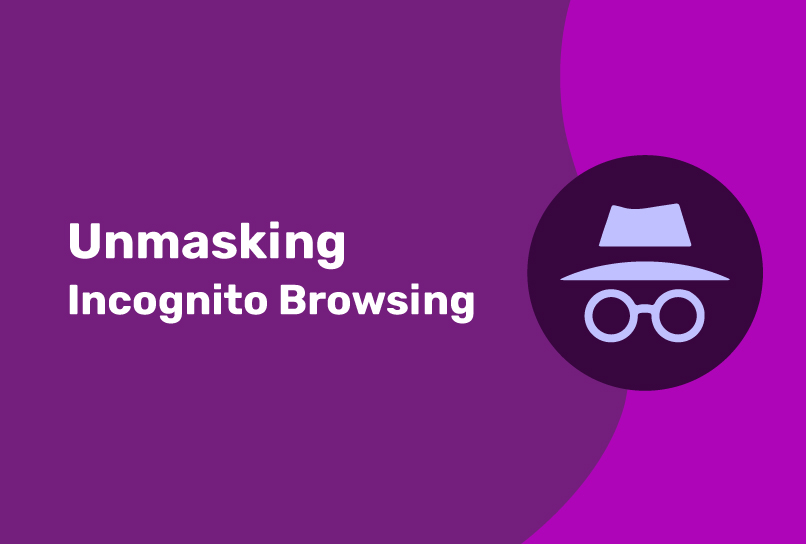Under various names like In-private mode, Private window, or simply Incognito tab, Incognito browsing — a feature found in popular web browsers like Chrome, Firefox, and Edge, has always stood as the trusted sanctuary for those seeking privacy online.
But do you know what exactly is covered by an Incognito browser tab, what remains vulnerable, and where that leaves you and your private data?
Using Incognito mode, major browsers provide a quick way to browse the web without saving local browsing data. But given its name (Incognito or private), many rely on Incognito tabs to keep their web activity anonymous. However, Incognito browsing has significant blindspots when it comes to preventing browser fingerprinting, the secret and advanced method website owners use to track visitors.
In this article, we’ll break down exactly what Incognito mode covers and what it doesn’t. We’ll also discuss the advantages and limitations of Incognito mode more broadly, and explore alternative solutions like VPNs, anti-fingerprinting browsers, and proxy tools that offer more comprehensive fingerprinting protection
Understanding How Browsing With Incognito Tabs Works
When you open an Incognito tab, your browser will clear your browsing history, cookies, site credentials, or cache files once the tab is closed. Each browsing session in an Incognito tab starts on a clean slate.
Browsing within an Incognito tab does two things:
Prevents your browsing history, cookies, and site data from being saved
This means that other people who use the same device will not be able to see what you have been browsing, and websites will not be able to track your browsing activity.
- Browsing History is not saved — The list of websites you visit during your Incognito session won’t be saved. When you exit the Incognito tab, it’s as if the journey (or session) never occurred.
- Site Data is not saved on your browser — Websites typically employ cookies to remember your login status or track your activity is transient in this mode. These cookies and session data won’t be saved beyond your Incognito session.
The significance of these becomes evident when sharing a device. Whether it’s a family computer or a public terminal, your online escapades won’t be inadvertently revealed to others. Also, websites won’t be privy to your previous visits, bolstering your privacy.
This is especially beneficial when conducting sensitive research or shopping for surprises, as it maintains a discrete boundary between your online activities and the rest of your digital life.
Stops your browser from sending tracking cookies to websites.
Tracking cookies are used by websites to track your browsing habits and build a profile of your interests. This information can then be used to serve you targeted ads. When you browse in incognito mode, tracking cookies are not sent, so websites cannot track your browsing activity.
Benefits Of Using Browsing in Incognito Tabs
A regular incognito browser tab from Chrome provides the following safety benefits:
- It prevents cross-site tracking via cookies and cached data, allowing you to use multiple accounts on the same sites.
- It offers quick and easy private browsing with just one click. Incognito browsing protects your privacy not by saving your browsing history. Thus, no one can view or monitor you via your browsing habits.
- Separation of concerns. Incognito browsing helps you to separate web activity from your main browser profile when you desire. Incognito mode can be convenient for tasks such as signing in to multiple accounts on the same website or testing websites without affecting your regular browsing experience.
Incognito makes it more difficult for websites to connect Incognito activity to your main browser profile and data. But nonetheless, it leaves some apparent loopholes for website owners and devs to exploit.
Limitations of Standard Incognito Mode
Incognito mode lacks several capabilities required for robust privacy:
1. Incognito mode does not protect against IP tracking and Browser fingerprinting. Websites can still track you, from simply tracking your IP address to more robust methods like browser fingerprinting – and that’s in fact what they do.
These more sophisticated techniques could pierce the veil of Incognito mode, compromising the anonymity it offers
2. It can be inconvenient to manage multiple incognito browser tabs over time. Incognito mode doesn’t preserve browsing data between sessions, making it impossible to continue where you left off.
And once you open many Incognito tabs, managing them becomes a cumbersome and disorganized process. No bookmarks, no history, no local storage.
3. It does not protect you against malware and phishing attacks. Browsing on an Incognito tab does not directly protect you from all online threats, such as malware and phishing attacks. It is simply not designed for that.
As a result, software can still find its way onto your system if you unknowingly visit a compromised website or download infected files.
Overall, Incognito tabs serve as a valuable tool, but it gives a false sense of security. It’s vital to recognize that while your data is not saved on the browser, more advanced tracking techniques, like browser fingerprinting are usually deployed by websites’ servers to track you in real-time.
To delve further, let’s explore the world of browser fingerprinting, understand its implications, and how it works.
What are Browser Fingerprints?
Browser fingerprints are unique identifiers that websites use to track users and gather information about their browsing habits. These identifiers are derived from specific characteristics of the user’s browser (and sometimes, their device), hence the name.
Usually, websites do not ask for consent to retrieve the information they use to make these browser fingerprints as they do for cookies. So it is always left to the user to find ways to thwart these tracking methods. One of the ways they do this is by browsing in Incognito mode.

What Browser Fingerprints Can Incognito Tabs Hide?
Though Incognito mode is limited in its capacity to stop or reduce browser fingerprinting, there is still a subset of data that it masks. These data points include:
- Browsing and clickstream data. Your browsing history, autofill data, and other forms of data regarding your activity on any website you visit in incognito mode are cleared immediately after you end the browsing session.
- Cookies from sites you visit. Popular tracking methods with cookies are ineffective when you browse in incognito mode. Cookies need to be stored on your device for them to work. However, they are cleared as soon as you close the incognito tab you browsed in.
- Cached images, files, and site resources. Browsing in incognito mode also prevents permanent storage cache and other files that allow a website to load optimally on your device. Sometimes, website owners sneakily add tracking bits to these files.
- Local browser storage like IndexedDB. This is another way websites store data on your browser. However, with Incognito mode, the data stored only exists temporarily. As soon as you close your session, the data gets cleared.
So because it prevents retention of browsing artifacts like cookies and cache files, browsing in Incognito mode provides some protection against browsers being fingerprinted based on your activity and history on specific sites.
However, many crucial data points for browser fingerprints still remain exposed when you browse the internet in incognito mode

Browser Fingerprints Incognito Tabs Do NOT Protect Against
The problem is that the basic isolation an Incognito tab provides does nothing to mask the many significant elements of a tracking fingerprint based on your underlying browser, device, and network. The following data points are important elements of a browser fingerprint that Incognito does not protect against.
- Browser version and user agent string
- Screen size and configuration
- Timezone and language settings
- Installed fonts, plugins, and extensions
- Canvas, WebGL, and other API fingerprinting
- Hardware fingerprints like CPU, GPU
- IP address and network identifiers
- Geolocation data
These fingerprints have nothing to do with isolating browsing data, and everything to do with the inherent traits of your device and browser configuration that websites can detect.
In essence, Incognito mode’s privacy protections are limited to just browsing data, while you remain highly fingerprintable via more intrinsic fingerprints.
How To Achieve Comprehensive Fingerprint Privacy: What if I need more safety than usual fingerprints of an Incognito tab?
To combat advanced fingerprinting, we need tools that make changes at a deeper browser configuration and network level.
Proxy tools and VPN
Proxy tools provide network-level protection. They route your traffic through intermediate servers to mask your real IP address and location. This is important because one of the key pieces of information collected during fingerprinting is your IP address.
VPNs do the same thing as proxies but with a twist. They encrypt the browsing data that is sent between your browser and websites.
However, your browser’s distinguishing characteristics are still visible. Therefore, VPNs and proxies should be combined with other measures.
Anti-Detect Browsers
Anti-detect browsers like Incogniton are purpose-built anti-fingerprinting browsers that conceal your real fingerprint by modifying browser traits by default. This provides in-depth protection while maintaining usability.
Incogniton and other top anti-detect browsers employ various techniques:
- Scrambling the user agent string and real browser version
- Limiting access to system fonts, plugins, and hardware details
- Blocking or altering fingerprinting scripts
- Sandboxing fingerprint-able components like HTML5 Canvas
- Normalizing browser headers to generic values
The most effective anti-fingerprinting browsers combine multiple methods while still allowing sites to function properly. This achieves vastly greater protection versus Incognito alone.
But sometimes manual configuration is required for maximum benefit.
Combining Solutions for Optimal Privacy
Deciding which approach to take depends on your specific privacy needs. For robust protection that digs deeper than Incognito, utilizing anti-fingerprinting browsers and other tools is a must. However, No single tool delivers complete privacy. Combining solutions balances protection and usability:
- Proxy + Anti-detect Browser: Masks IP, location, and browser traits.
- Anti-detect browser + VPN: Masks IP, location, and browser traits and encrypts browsing data
With the right blend of tools, it’s possible to browse anonymously while maintaining a usable experience.
The tradeoff is added complexity versus the convenience of standard Incognito. Finding the right balance depends on your priorities and level of technical comfort.
Standard Incognito Mode: – Hides browsing data like history, cookies, and cache. – Easy one-click private browsing on demand. – Isolates activity from the main browser profile. – No protection against advanced browsers, hardware, and network fingerprints. | Anti-Fingerprinting Alternatives: – Actively modify browser traits and network traffic to mask fingerprints. – Provide strong protection against advanced tracking techniques. – Maintain usability without major feature loss. – Require more specialized tools and possible technical expertise. |
Conclusion
When used properly, Incognito mode provides a useful lightweight privacy option. However, its inability to combat advanced fingerprinting necessitates additional tools for true anonymity. By employing the right blend of anti-tracking solutions, individuals can take control of their identities and browsing habits in the digital sphere.
The availability of privacy-preserving alternatives empowers you to choose tools that address your specific needs. Only through recognizing privacy as an inherent right can society develop technology that serves humanity’s best interests.
Anti-Detect Browser for Multi-Account Management
Manage unlimited virtual profiles for easy multi-account management. Safe and anonymous. Ideal for teams and individuals. Download and try for free now!

Comments are closed.